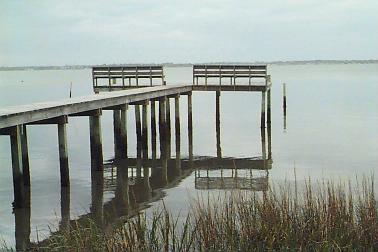
At almost any surface some light is scattered and caused to go in a new direction. When the surface is smooth and flat, the new direction of the light beam is related to its previous direction in a simple way, and we have a mirror. The reflected light beam now seems to come from the mirror, and the light source seems to be "beyond the looking glass."
Water and glass reflect only a few percent of the light
striking them; the rest travels on through the surface.
We will only see our reflection in a window if it is dark
outside, and even then it is a dim image. Coating a surface
with metal makes a very reflective surface.

The amount
of light that is reflected from glass or water is
greater when the angle
between the light beam and the surface is small.
That is why
it is hard to tell where the pier
meets its reflection in this picture.
We use mirrors every day to see outselves; we might also
use them in a periscope to see other things. A dentist uses
a mirror to see our teeth from the back or below.
|
Coating a window to make it more reflecting decreases the amount of energy that it transmits, keeping the sun from heating a building too much. |
|---|
 |
| Looking at one building, we
see the reflection of another building |
|---|
 |

A building that happens to be turned the right way
reflects the setting sun.
The unit on mirrors